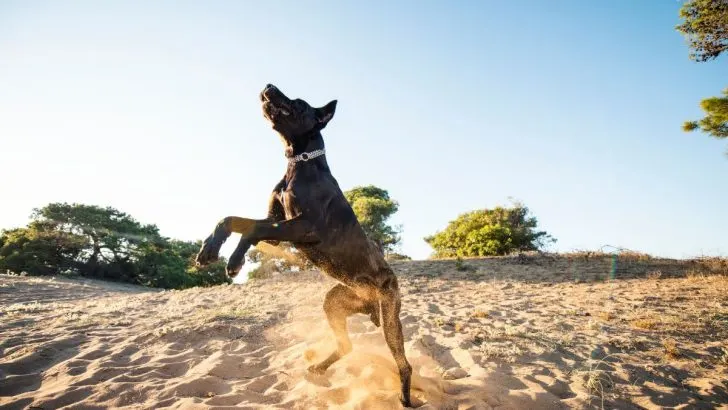Are you looking to buy this amazing gentle giant but are baffled at the number of Great Dane colors out there? No worries – here’s everything you need to know in one place!
The Great Dane is a popular breed initially bred to be used in dog sports. Nowadays, however, most people get them so they can be family pets or guard dogs.
What many people don’t know is that these beautiful dogs come in an array of coat colors. From standard black or blue to unique shades such as harlequin, this is one of the most colorful breeds out there!
Without further ado, here are some common Great Dane coat colors – and others that are not so common:
Standard Great Dane Colors
Some colors are considered a part of the breed standard set by local canine organizations.
In the United States, the main organization is the American Kennel Club (AKC), but many others exist in the world, such as Federation Cynologique Internationale (FCI) and the United Kennel Club (UKC).
While the list of official Great Dane colors can depend on the canine organization, I’ll stick to the AKC’s list for this article, just to make things more clear.
This is also the list that the Great Dane Club of America (GDCA) follows, making everything even more straightforward!
The AKC recognizes 17 Great Dane colors, meaning that all of them are naturally found in his dog’s genetics. However, only 10 of them are considered a part of the breed standard. These are the only colors you can use to participate in dog shows.
Here are the unique color combinations experts consider desirable in this dog breed:
1. Black Great Dane
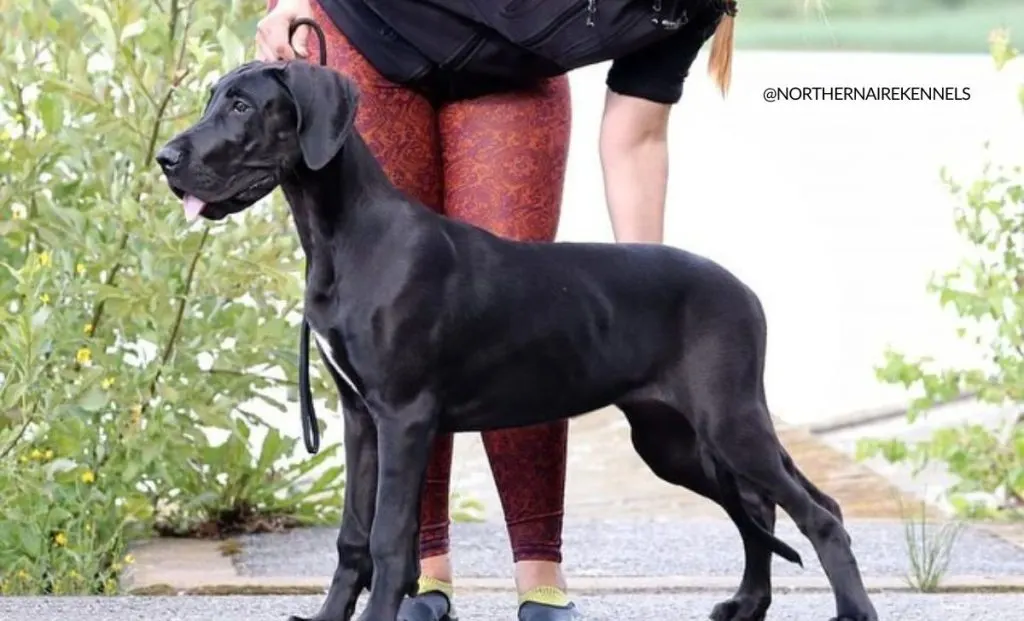
Black Danes are quite standard, although they are not as common as some other dog breeds.
These pups have a glossy, solid black coat, black noses, eye rims, and paws, as well as dark brown eyes.
Most will have some minor white markings, typically on their chest, but this isn’t a recommendation.
While black Great Danes are extremely desirable, both by experts and by dog lovers worldwide, they aren’t more expensive than most other colors, which is always a good thing.
2. Black And White Great Dane
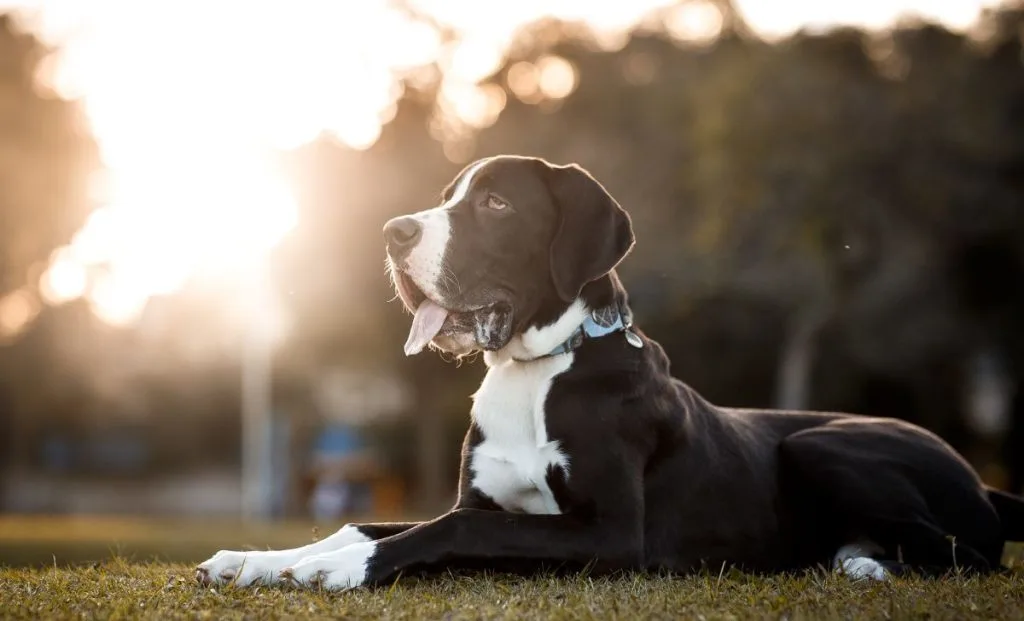
Black and white Great Danes are quite similar to the Danes I’ve just mentioned. They have black fur, but the white markings are much more prominent and impossible to ignore.
Still, the markings shouldn’t cover a huge portion of the dog’s fur. Otherwise, the dog might be considered harlequin or mantle.
Just like black Danes, these pups also have dark eyes and noses.
3. Blue Great Dane
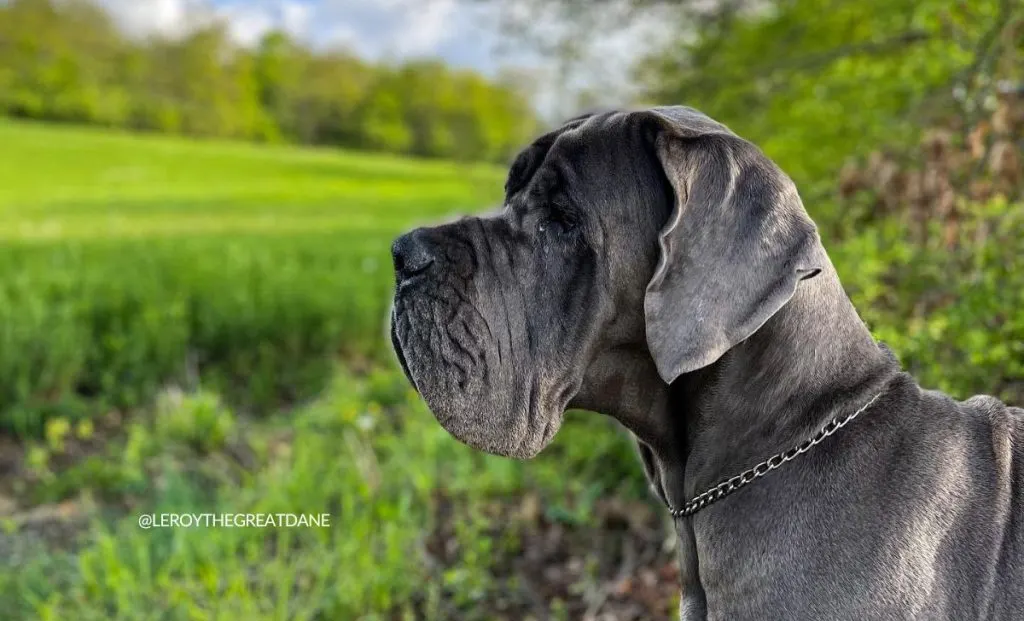
Blue is a unique color that is quite popular in certain dog breeds, such as Pitbulls. It is also a pretty loved color in the Great Dane breed, although it is somewhat rare.
This shade is the result of recessive genes that will dilute the coat to a gorgeous blue color.
Typically, blue Danes have consistent coats, although some minor white markings are allowed, as long as they’re not too visible.
While solid blue Danes are a part of the breed standard, the same cannot be said for any other variation of the blue coat.
This is probably because the dilution gene is connected with color dilution alopecia (CDA), a mysterious condition resulting in itchy skin and hair loss.
Only a handful of blue dogs will develop CDA, but this health condition wasn’t found in almost any other color.
4. Brindle Great Dane
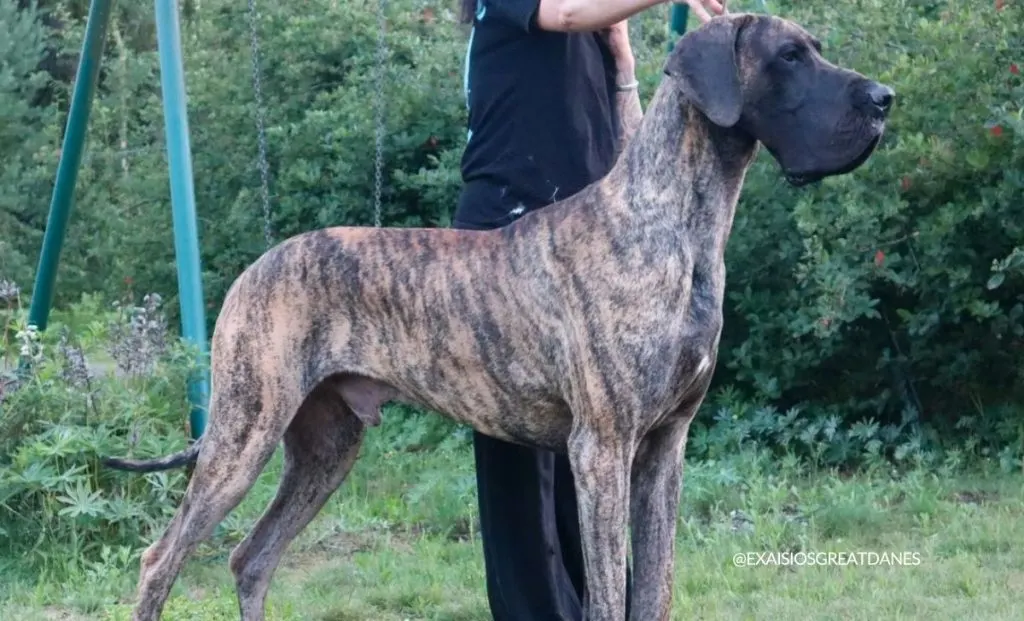
At first, you might notice something weird going on with this Dane’s coat. Then, at the second look, you’ll notice the tiger-like stripes.
That’s the brindle pattern!
Brindle Great Danes have a base coat, which is typically a fawn or a tan color, with dark brown or black stripes. Some white patches are also possible, as long as they’re not too prominent.
The genetics behind the brindle color are quite complex, and it isn’t yet entirely certain what’s causing it in the Great Dane breed. Some research suggests the genes that cause brindle are dominant, but this is yet to be fully proven.
5. Fawn Great Dane
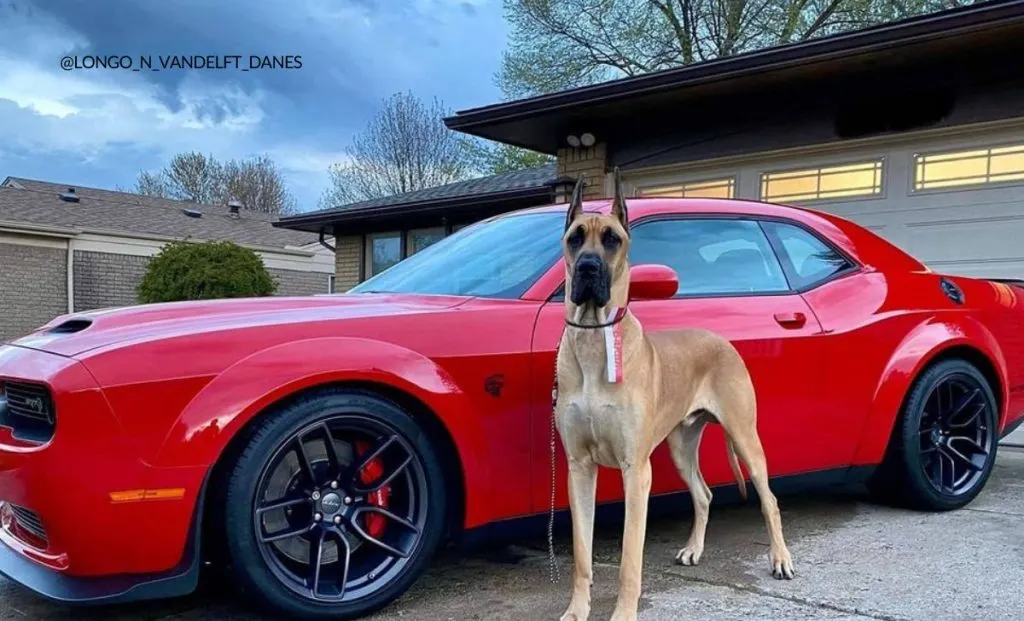
Do you know of Scooby Doo? You probably do! But do you also know that he is a fawn Great Dane?
Fawn is probably the most common shade in Great Danes, but this doesn’t make it any less beautiful than other rare colors.
While the exact shade experts consider fawn might vary from breed to breed, in Great Danes this color resembles a light tan, almost ginger color.
While these pups are always solid-colored, they do have a black mask. Any other spots are considered flaws.
6. Harlequin Great Dane
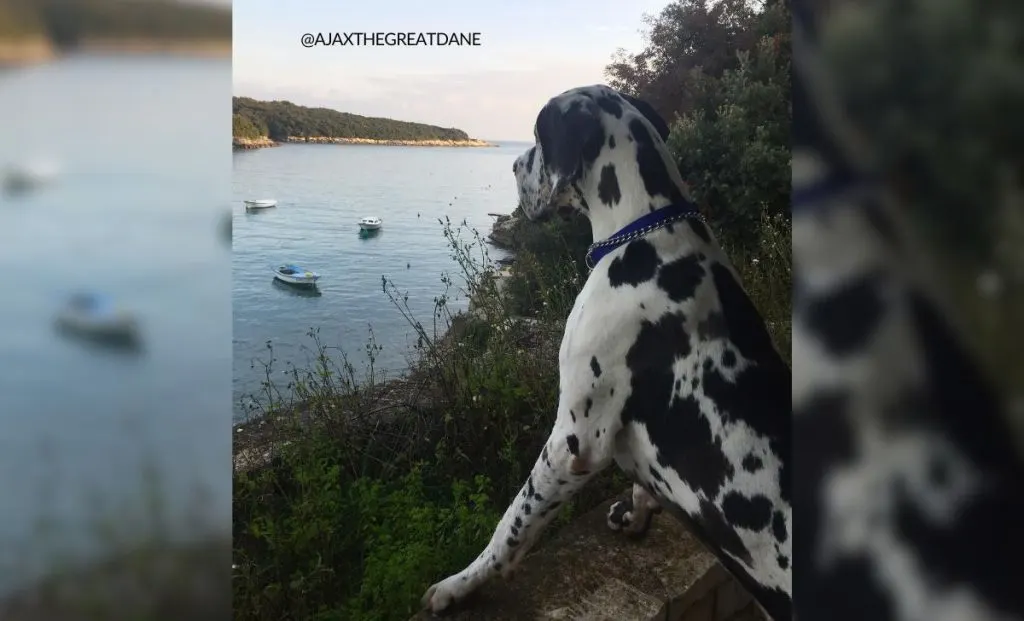
Harlequin Danes have a funny name, but they are actually quite beautiful.
Their main color is white, but they have patches of another color – usually black, but gray harlequins are also common. These spots are not symmetrical, and every harlequin Dane is quite
The ideal pattern shows white on the dog’s neck, shoulders, and front legs, while hind legs and back have more coloring.
However, other combinations are also possible.
Harlequin Danes are fairly rare because they are challenging to breed. It requires a unique combination of genes to get a harlequin Dane, and even some of the most reputable breeders might struggle to get a perfect harlequin.
7. Mantle Great Dane
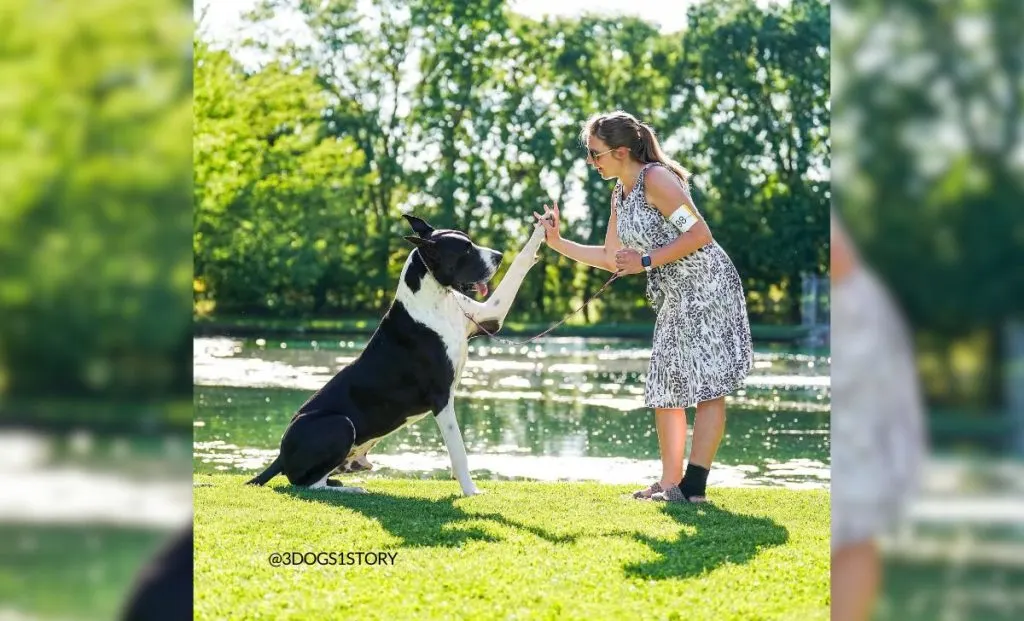
At first glance, you might think mantle Great Danes are the same as black and white ones. However, at a closer look, you’ll see that the pattern is quite easy to differentiate from the others.
A mantle Dane must have a black skull with a white muzzle. The black should cover the dog’s back and hind legs, but the front legs should be mostly white. It looks as if your dog is covered in a black blanket!
Compared to most other Great Dane colors, the mantle doesn’t have many variations. There’s no mistaking whether a dog is a mantle or not!
Genetic testing has shown that mantle Danes come in two genotypes, and that either one of them can result in a mantle coat. Due to this, they are not as rare as some other colors.
8. Merle Great Dane
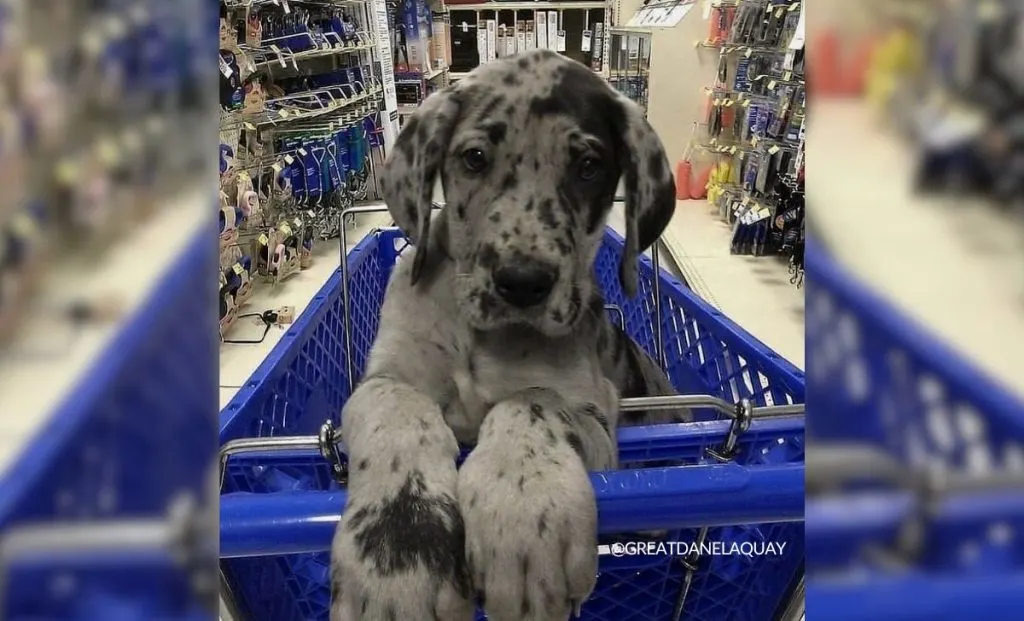
Merle is a pretty unique pattern. It consists of a white base coat with patches of black and blue. They commonly have butterfly noses and blue eyes or even heterochromia.
Great Danes are one of the very few breeds in which the merle color is allowed. Australian Shepherds are another such breed. Why is it that the merle is so undesirable?
The reason is double merles.
The merle color is the result of a unique dominant gene that causes partial dilution. When the pup inherits it from just one parent, you get the color you see in the picture above.
However, if the dog inherits the merle dilution gene from both parents, he becomes what is known as the double merle. These pups are white in color, with blue eyes.
While this is a truly stunning look, these pups have some special needs because the merle dilution gene leads to hearing and vision loss.
Due to this, some people are against breeding merle dogs.
While the solution to this sounds simple – we simply shouldn’t breed two dogs with the merle pattern – some dogs have the merle gene that cannot express itself because they don’t have black on their coats. These are known as cryptic merles.
As you cannot differentiate cryptic merles from regular dogs, it is entirely possible to accidentally breed them with regular merle dogs, resulting in a sickly double merle.
Of course, reputable breeders conduct extensive genetic testing to ensure they know the genetic background of all of their dogs.
9. White Great Dane
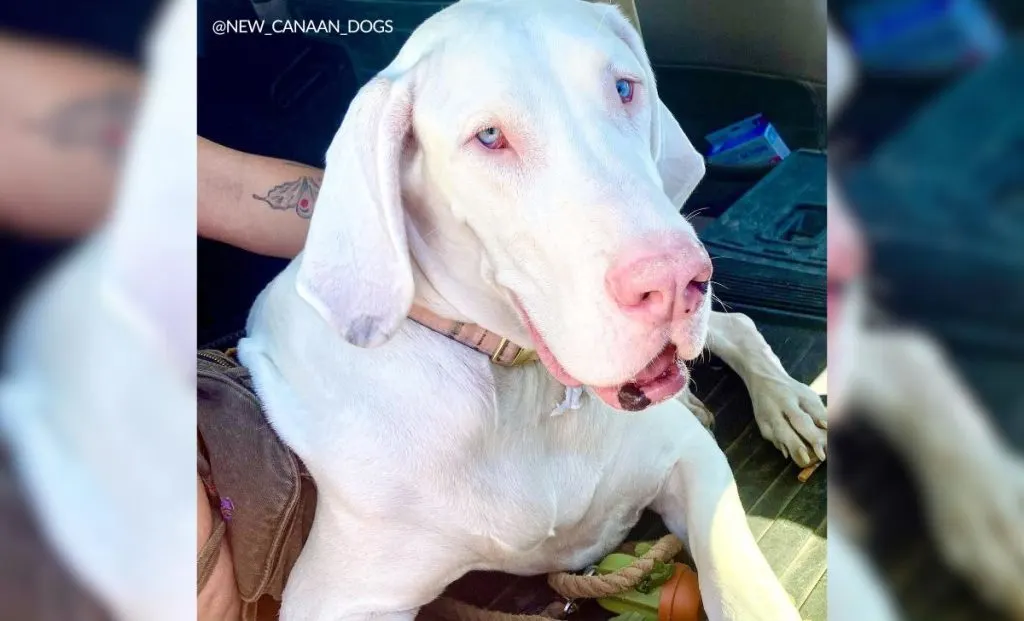
As their name states, white Danes have a fully white coat. Some might have a tiny spot of black or other color on their body, but this is considered a fault.
These pups should always have dark eyes and black noses.
The white color is considered a fault in many dog breeds as it can be connected with numerous health issues.
As I’ve already mentioned, white Danes with bright blue eyes are usually double merles that come with a plethora of health issues.
Some white dogs are the product of albinism. Albinism is a rare condition that strips any pigment from the affected dog. As a result, the pup will have a white coat, pink skin and nose, and light blue eyes with a reddish tint.
No serious breeder would intentionally breed a Great Dane with albinism, and fortunately, this condition is quite rare.
Still, you should always be careful when choosing a white Dane and only stick to a good breeder who knows what they are doing.
10. Silver Great Dane
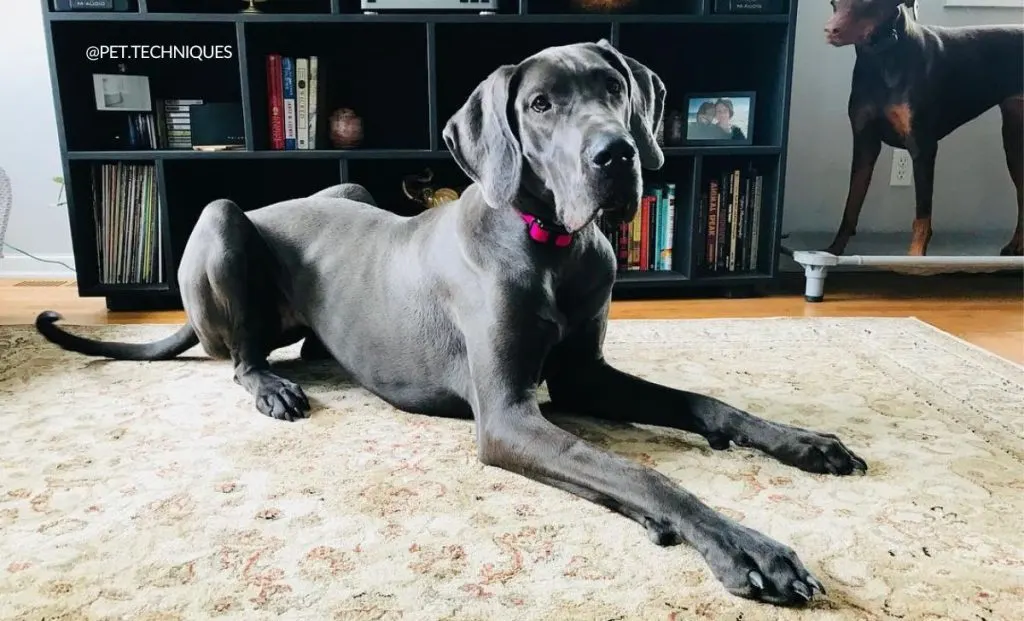
The silver Danes are the product of the same genes as blue Danes, but the exact color looks different.
These pups have a coat that varies in shade from light gray to dark silver, with a strong shine. They typically have dark blue eyes with blue noses, paw pads, and eye rims.
Just as is the case with black Danes, tiny white spots on the chest are quite common but undesirable, and solid colors are much more prized.
These doggies can never have any black on their bodies, as it’ll be diluted due to the blue gene.
Other Great Dane Colors
Great Danes can also come in a few rare colors that are either not accepted by the AKC or are simply not considered a part of the breed standard.
Some of these colors are not standard as they are connected with some health issues. Others are simply not fulfilling the aesthetic expectations of a certain breed.
Finally, some rare colors not accepted by canine organizations are simply not a part of the dog’s genetics. If they are present, this is a likely indication your pooch is actually a Great Dane mix.
Here are a few more different coat colors these massive pups can come in:
1. Blue And White
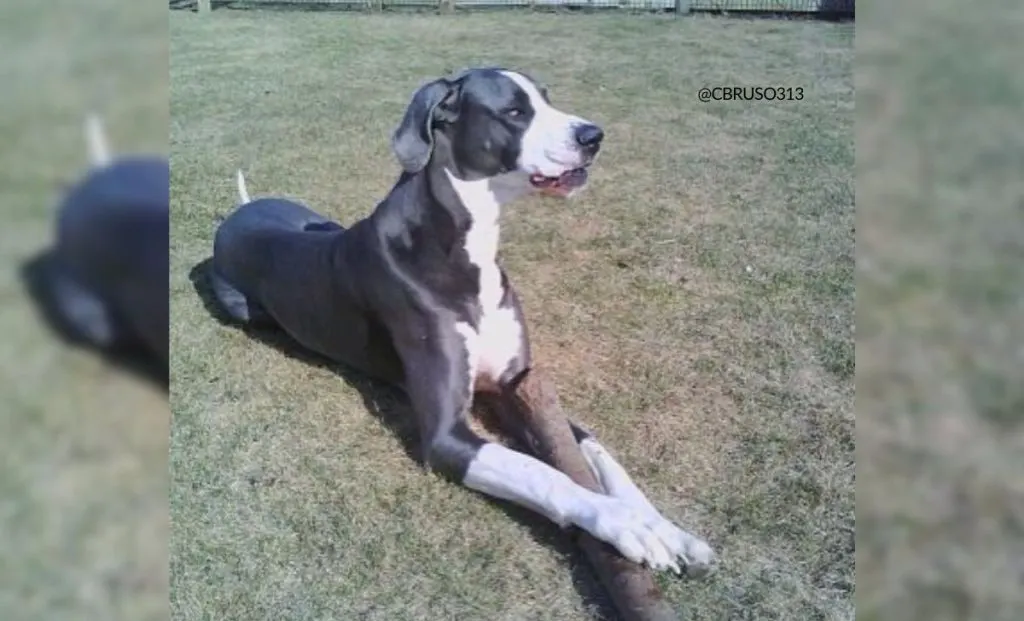
Blue and white is caused by the same blue gene as the standard blue Dane. However, this pup has white markings present, which is considered undesirable and thus, this color is not accepted.
These dogs always have blue noses and eyes, as it’s impossible for them to have any black pigment.
2. Blue Brindle Great Dane
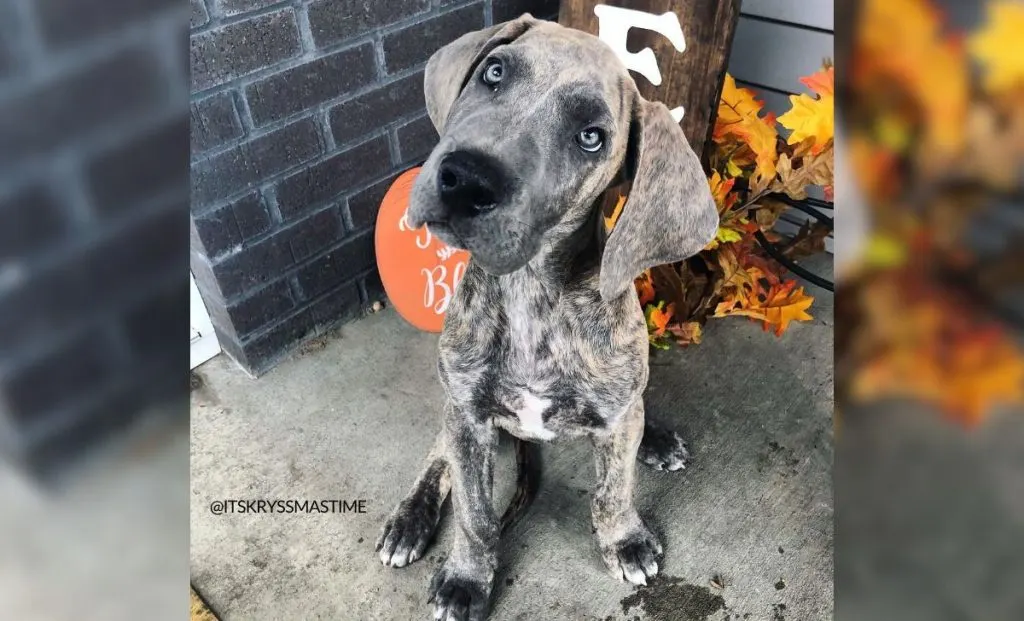
Blue brindle is a beautiful and unique color variation. These are brindle dogs with the blue dilution gene, which means any black pigment is turned into blue or gray.
Typically, these pups have a fawn base coat and dark blue stripes, blue noses, and blue eyes, but this can be reversed.
This is an extremely rare Great Dane color, which is a pity considering just how beautiful these doggies are.
3. Chocolate Great Dane
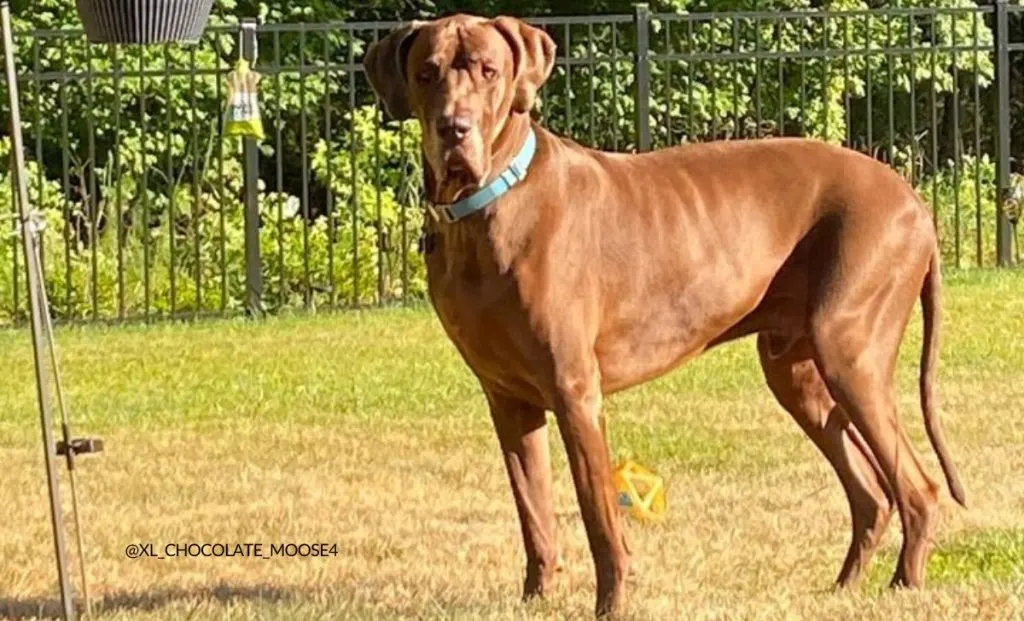
Chocolate Great Danes, also known as liver Danes, are actually black Danes with a dilution gene. No, this isn’t the same dilution gene that causes the blue color. Instead, it dilutes the black into the gorgeous color of hot chocolate.
These doggies typically have brown coats, brown noses, lips, eye rims, and paw pads, as well as hazel or amber eyes.
However, any Great Dane that has a brown nose can be considered a chocolate Great Dane. For example, you might find a fawn Dane with a brown nose and light eyes (and, of course, without the black mask, as it’s impossible to have black hair with this genetic combination).
While they might not look the part, these fur balls would also be considered chocolate/liver.
4. Chocolate And White Great Dane
Chocolate and white Danes are essentially black and white Danes with the liver dilution coat.
Similarly to Chocolate Danes, these canines have brown noses and hazel eyes, and they might have some other coat color – although this is extremely rare.
5. Chocolate Brindle Great Dane
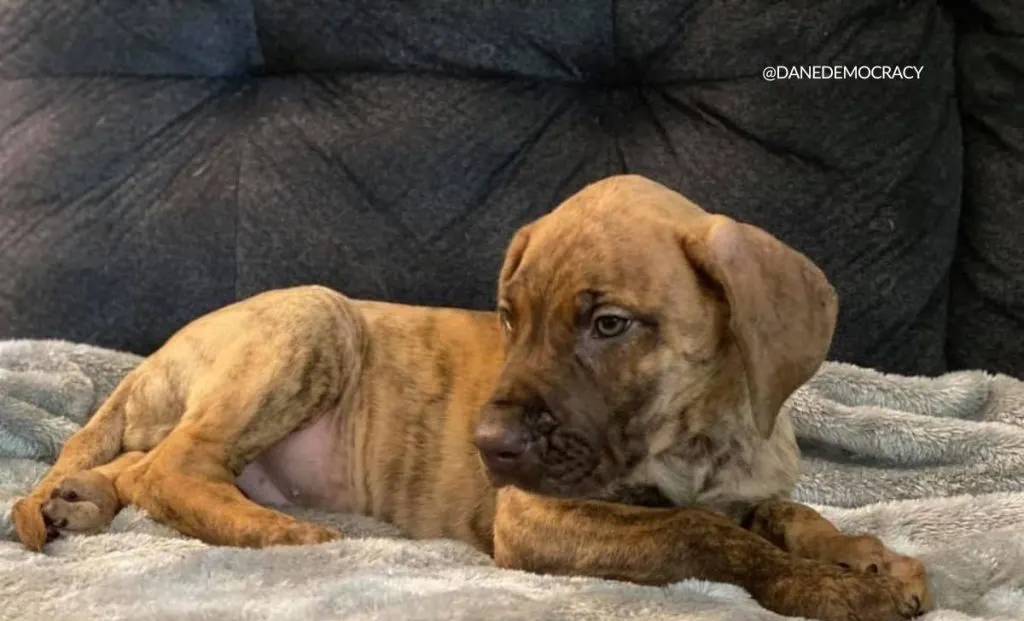
You probably already know where this is going.
Chocolate Brindle Danes are Brindle Danes with the chocolate dilution gene. This means that any black pigment is turned into liver.
They usually have fawn coats with liver stripes combined with some minor white markings. This results in a beautiful combination that is like no other.
6. Mantle Merle Great Dane
Mantle Merle Danes are probably the rarest of all Great Dane colors. These are the mantle Danes with the merle gene.
As a result, these pups have a merle pattern that is located in the same area as black in regular mantle Danes, giving them the appearance that they’re covered in some weird two-colored blanket.
While not considered a part of the breed standard, they are still accepted by the AKC. However, they are somewhat controversial, just like any other merle variation.
7. Merlequin Great Dane
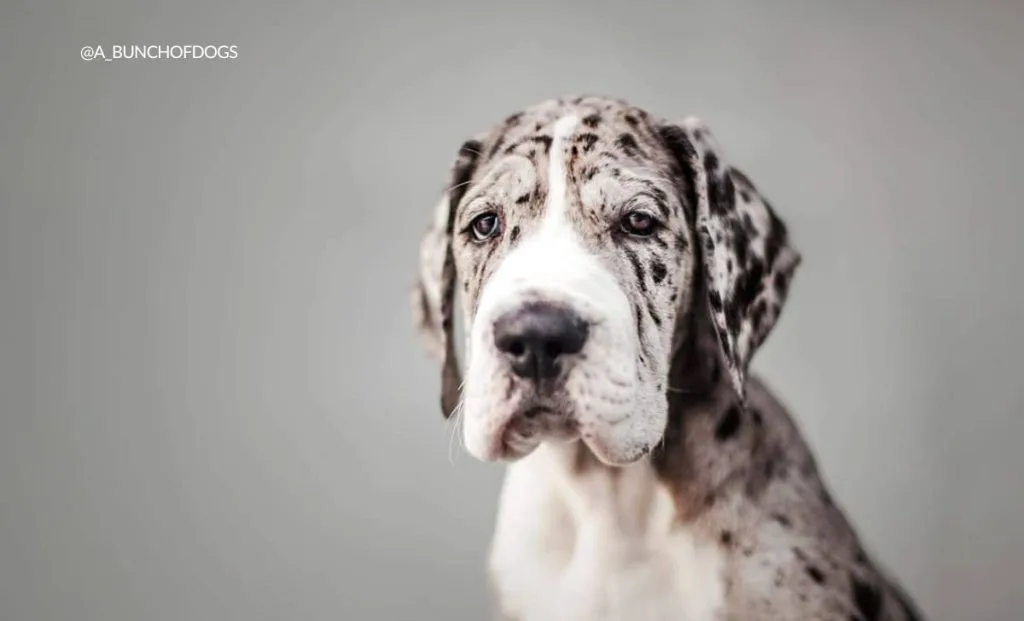
Merlequin Great Danes are – you’ve guessed it – harlequin Great Danes with the merle gene.
These pups can have patches of merle on the white base coat. Others have a blue base coat with patches and spots of black and white.
This is another highly prized Great Dane color that can be extremely expensive. Considering how beautiful and one-of-a-kind they are, this isn’t hard to understand.
Some merlequin Danes are challenging to differentiate from standard merles, and many consider them to be one and the same color.
However, if you look carefully, you’ll notice that they still have a base coat with localized patches of other colors, while standard merles have a merle pattern equally distributed all over their bodies.
8. Blue Mantle Great Dane
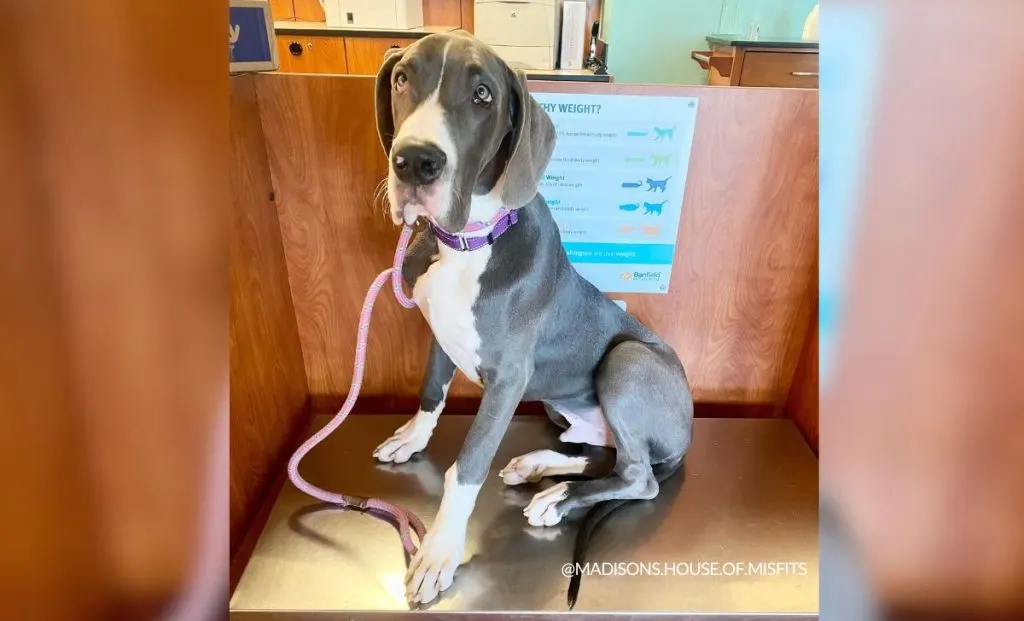
Mantle Great Danes are a rare variation of mantle Danes. They have the same blue dilution gene that causes blue color, but this time it is localized on that blanket pattern.
Blue mantle is considered by many to be one of the most beautiful Great Dane colors, although I would say the competition is tough.
9. Blue Fawn Great Dane
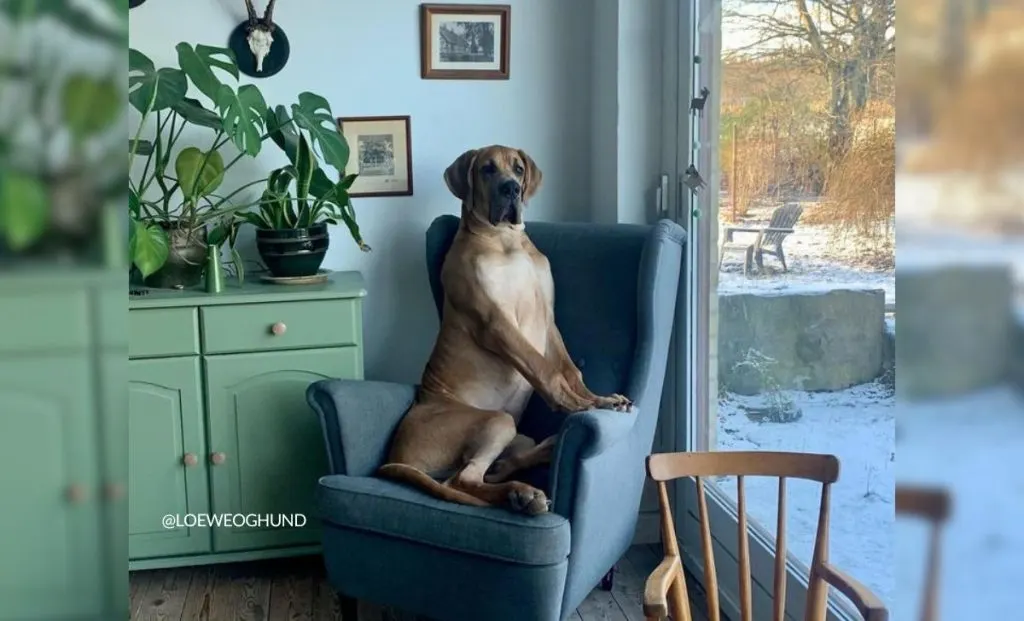
Blue fawn is a color combination that is challenging to notice if you don’t know what to look for.
These pups have a blue dilution gene. However, as their coats are white, they remain unchanged.
The same cannot be said for their noses, paw pads, lips, and eye rims, which will become blue or gray.
These pups are not recognized by the AKC. Still, this doesn’t have to mean they aren’t purebred, considering how the genes that cause both fawn and blue are commonly found in this breed.
Do Colors Even Matter?
Some people might wonder whether a coat color might affect their dog in any way.
The good news is, most things you hear are just prejudices. Great Dane color won’t affect his personality in any way, shape, or form.
On the other hand, as I’ve already mentioned, some colors are connected with specific health issues, which can greatly affect their quality of life.
Also, you might run into breeders selling dogs in colors that aren’t on the AKC’s list. These rare colors are often an indication that these pups are mixed breed, no matter what the breeder says.
If a color isn’t naturally found in the breed, the only way this color can enter the gene pool is by crossbreeding.
Alternately, this can result in your dog having a different temperament from what you might expect, as they will have a different background. When dealing with big dogs such as Danes, this can be quite tricky. You might’ve ended up with a pup you don’t know how to handle.
Other than that, the Great Dane color truly doesn’t matter. These pups are amazing pets for the right families and can be great companions to both small children and other pets.
No matter your choice, I am certain you’ll love your new four-legged companion!
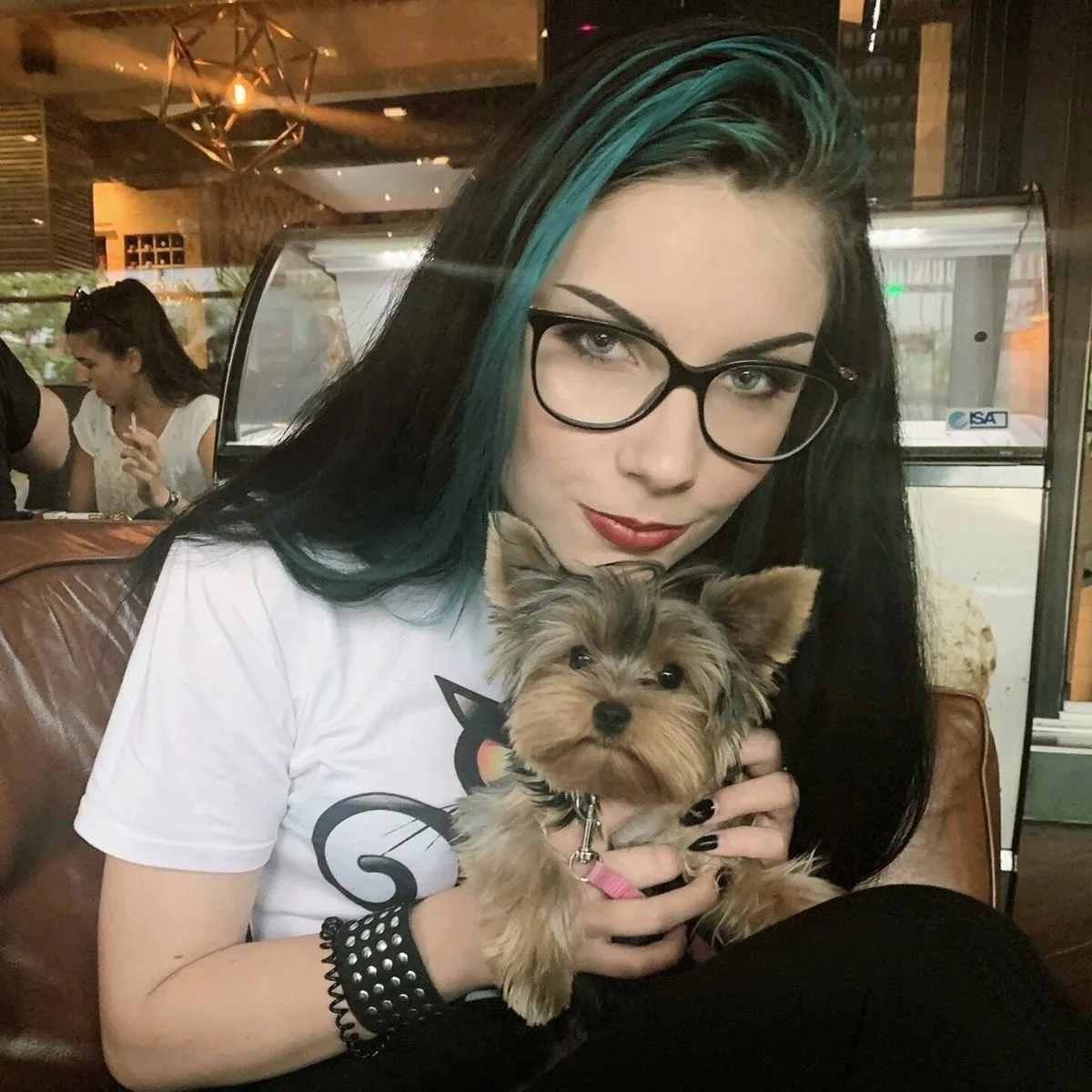
Vanja’s passion for writing started at an early age, which is why she pursued Journalism as her college degree. She can research any topic and find all the information before you bat an eye, which is a great thing for her job but a terrible one for her husband.
Even as a young child, she fell in love with everything fluffy – but dogs have a special place in her heart due to her childhood companion, a Corgie named Archie.
Motivated by her experiences and driven by a desire to give back to her four-legged companions, she spends her free time volunteering at a local dog shelter.
